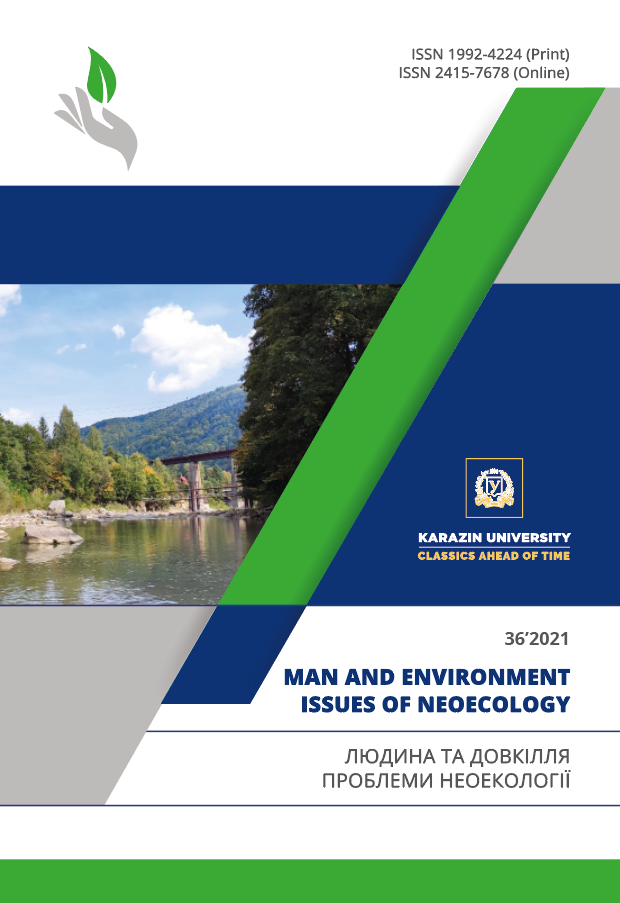IT Technology for Establishing Borders of Reserved Territories in the Conditions of Land Reform in Ukraine
Abstract
The existence of only a paper outline scheme in the National Nature Park Project does not allow to unambiguously interpret the boundaries of the object.
Purpose. Development of technique for establishing the boundaries of protected areas.
Methods. Cartographic using the ArcGIS geographic information system
Results. The basic cartographic document for the study was a scanned map at a scale of 1:50 000 showing the boundaries of the Gomilshansky Forests National Park from the National Nature Park (NNP) Project. The main problem was the lack of elements of its mathematical basis on the map. The IT technology of geo-linking the scanned map of the park boundaries in the GIS environment includes the following actions: linking topographic map sheets at a scale of 1: 50,000 in the ArcGIS geographic information system, saving the relevant geo-linked, transformed copies of the image; visualization of digital geodata with geometry and coordinates of points of boundaries of forest areas (quarters); download the scanned map of the boundaries of the NNP from the Project of creation without geographical reference and perform the procedure of sequential addition of control points of reference; image transformation and saving the result in geotiff format. After that, a polygonal vector layer of * shp format was created and the park territory was digitized according to the NNP Project. The result of the research was a map of the boundaries of the Gomilshansky Forests National Park in geotiff format, geographically linked in the ArcGIS environment, as well as a vector layer of the National Park's territory based on it.
Conclusions. The use of the developed technology allows to determine the location of any land plots in relation to the national nature park, knowing their coordinates or uploading the Public Cadastral Map of Ukraine to the GIS project.
Downloads
References
Law of Ukraine About the State Land Cadastre. (2021). Retrieved from https://zakon.rada.gov.ua/laws/show/3613-17
Law of Ukraine About Land Management. (2021). Retrieved from https://zakon.rada.gov.ua/laws/show/858-15
Law of Ukraine About Scientific and Scientific-Technical Examination. (2020). Retrieved from https://zakon.rada.gov.ua/laws/show/51/95-%D0%B2%D1%80
Law of Ukraine on the national infrastructure of geospatial data. (2020). Retrieved from https://zakon.rada.gov.ua/laws/show/554-20
Law of Ukraine about the nature reserve fund of Ukraine. (2017). Retrieved from https://zakon.rada.gov.ua/laws/show/2456-12/ed20170903
Law of Ukraine about topographic, geodetic and cartographic activities. (22021).. Retrieved from https://zakon.rada.gov.ua/laws/show/353-14
Land Code of Ukraine. Retrieved from :https://map.land.gov.ua/
Martin, A.G., & Avramchuk , B.O. (2018). Land management in the European Union: areas of adaptation for Ukraine. Land management, cadastre and land monitoring, (1), 4–13. http://dx.doi.org/10.31548/zemleustriy2018.01.001
Novakovsky, L. (2013). Modern problems of land relations in Ukraine. Land Management Bulletin, (6), 2-6.
Law of Ukraine Public cadastral map.. Retrieved from https://map.land.gov.ua/
Law of Ukraine About local self-government in Ukraine. Retrieved from https://zakon.rada.gov.ua/laws/show/280/97#Text
Law of Ukraine On the basics of urban planning. (2020). URL: https://zakon.rada.gov.ua/laws/show/2780-12
Law of Ukraine About planning and building of territories. (2021). Retrieved from https://zakon.rada.gov.ua/laws/show/1699-14
Regulations on the Project of organization of the territory of the national natural park, protection, reproduction and recreational use of its natural complexes and objects. (2014). Retrieved from https://zakon.rada.gov.ua/laws/show/z0831-05#Text
Authors reserve the right of attribution for the submitted manuscript, while transferring to the Journal the right to publish the article under the Creative Commons Attribution License 4.0 International (CC BY 4.0). This license allows free distribution of the published work under the condition of proper attribution of the original authors and the initial publication source (i.e. the Journal)
Authors have the right to enter into separate agreements for additional non-exclusive distribution of the work in the form it was published in the Journal (such as publishing the article on the institutional website or as a part of a monograph), provided the original publication in this Journal is properly referenced
The Journal allows and encourages online publication of the manuscripts (such as on personal web pages), even when such a manuscript is still under editorial consideration, since it allows for a productive scientific discussion and better citation dynamics (see The Effect of Open Access).





